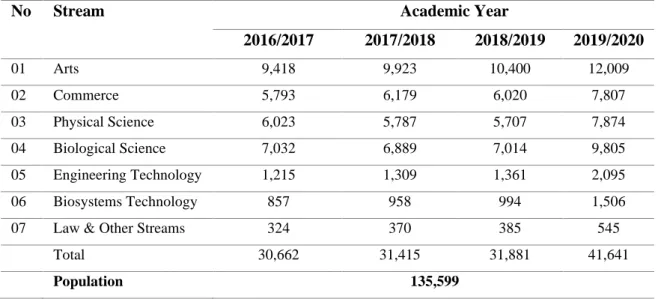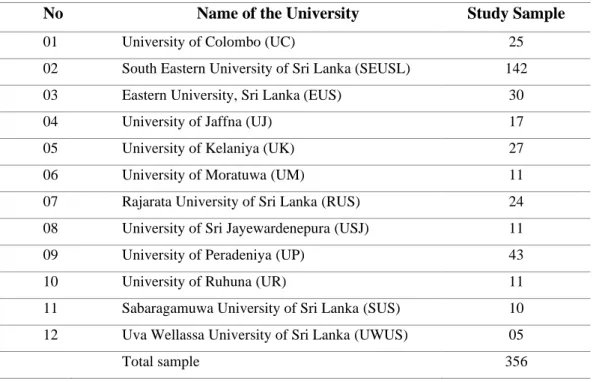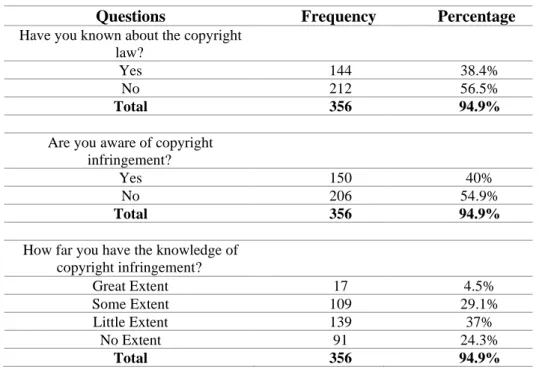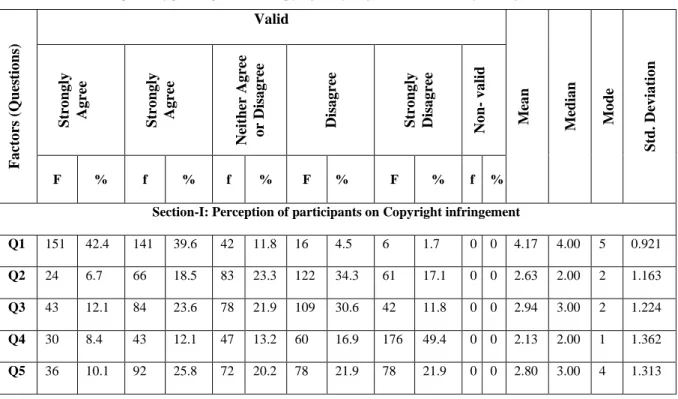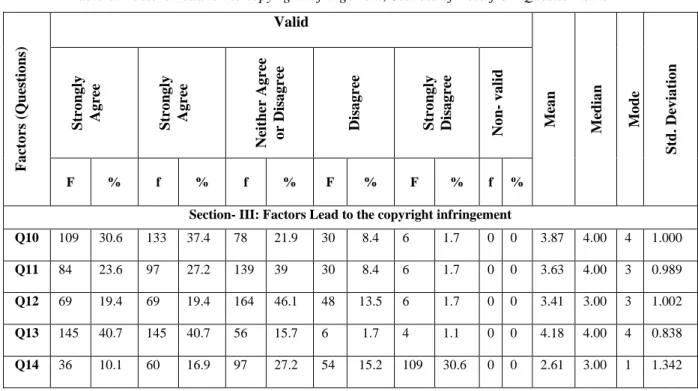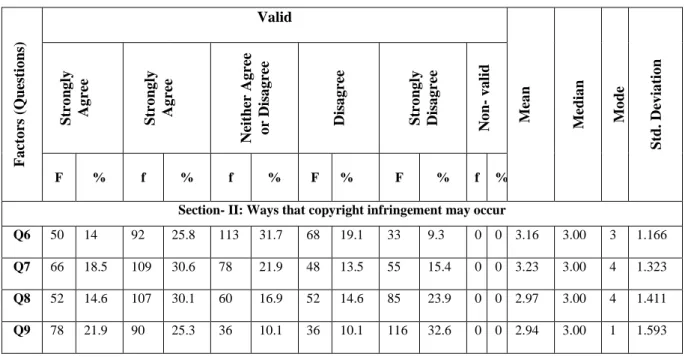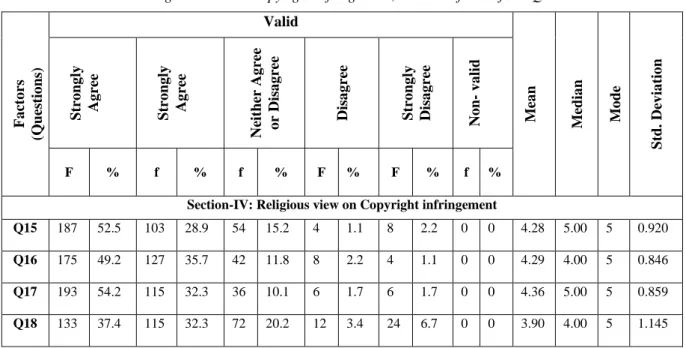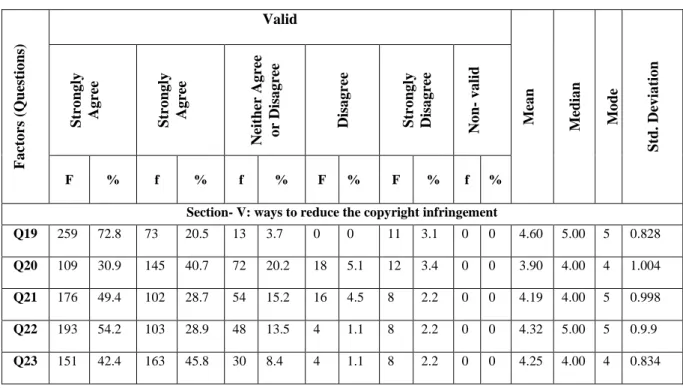In this regard, copyright can be seen as a permission granted to others for the appropriate use of the author's work. This effort was considered the first copyright law passed in the history of the world (Patry, 2003). During this period there were significant changes in the field of politics, economy and culture of the country.
Using these assets without the permission of the copyright holder may be considered copyright infringement. The aforementioned section of the Act makes copyright infringement a criminal offense under the Intellectual Property Act of Sri Lanka. These are: undergraduate students' perceptions of copyright infringement, how copyright infringement occurs, factors that lead to copyright infringement, copyright infringement from a religious perspective, and ways to reduce copyright infringement.
DATA ANALYSIS
RESULTS
The awareness of the participants about copyright infringement and the copyright law of Sri Lanka.
The Awareness of The Participants on Copyright Infringement and The Copyright Law of Sri Lanka
Perception of participants on Copyright infringement
A total of 35.7% of respondents agreed and strongly agreed that such activities would constitute copyright infringement. This shows that most students were not aware that using the ideas from the works of others is a violation of copyright law. The fourth question concerned whether renaming another author's work and submitting it as one's own would constitute copyright infringement.
The majority of respondents (66.3%) agreed and strongly agreed that such an action would constitute copyright infringement, while 20.5% of respondents stated that such an action does not constitute copyright infringement. copyright and an additional 13.2% of respondents were neutral in this regard. The fifth question concerned whether using copyrighted works without proper citations and references would be copyright infringement. In summary, only a small majority of respondents were aware that copyright infringement is an expression of intellectual dishonesty, that authors' names must be mentioned when using copyrighted works, and that using works by paraphrasing and renaming other authors' works as their own is copyright infringement, while a small majority were unaware of the need to provide proper citations and references when paraphrasing or using ideas from copyrighted works in their works such as assignments, research papers and dissertations.
The Ways Copyright Infringement Occur
Regarding the practice of copying ideas verbatim from copyrighted books (T7), the majority of respondents (49.1%) admitted to having practiced such copyright violations, while 28.4% did not and 31.7% were neutral. Regarding the question about using miscitations when writing research articles, dissertations or other works related to the academic field, the majority of respondents (42%) admitted that they had done so, while 38.2% did not and 16% were neutral. For copying Internet resources without the prior permission of the authors and republishing them under their name, more than 45% agreed that they had done so, and 28.9% of the participants did not, while 21.9% of the sample of studies have shown neutrality.
In summary, most of the respondents are involved in copyright infringement activities such as paraphrasing and using other authors' works, copying the ideas of other authors, misquoting and using internet sources without prior permission.
The Factors That Lead to The Involvement of Copyright Infringement
The View Of Religion on The Infringement of Copyright
The majority of respondents (86.5%) agreed with the question whether copyright infringement is an act equivalent to theft of someone else's physical property (movable and immovable property), while only 3.4% agreed. All the revealed religions of the world have generally prohibited theft, as it is an act of trespassing on property that belongs to someone. Finally, when asked whether copyright infringement is a crime based on their religion, the majority of respondents agreed and strongly agreed (69.7%), while only 10.1% of respondents disagreed.
We can conclude that the respondents are aware that according to religious teachings copyright infringement is a prohibited practice.
The Ways to Reduce Copyright Infringement Practices
HYPOTHESIS TESTING
HI - There is no association between respondents' academic stream and awareness of copyright law. The chi-square (Pearson chi-square) study statistic for this table is 261.609 and has 4 degrees of freedom. Therefore, according to this hypothesis test, it can be understood that there is no relationship between the samples' education and copyright law awareness in the study area.
DISCUSSION
Similar practices have been identified in studies conducted in other parts of the world. For example, Tella & Oyeymi (2017) found that the main copyright violations that occur among students at the University of Ilorin in Nigeria are reproduction of literature without the prior permission of the author, distribution of works to third parties, display of copyright works. in public places and use of copyrighted works as a derivative work. In our study, the majority of respondents agreed that the main factors leading to copyright infringement are lack of awareness about copyright law, the high cost of textbooks and fear of getting low grades.
Tella & Oyeyemi (2017) identify lack of awareness about the copyright law and the high price of textbooks as the main factors for the infringement of copyright in Nigerian universities, as well as the scarcity of literature and the fear of getting low grades. Similarly, Igudia & Hamzat (2016) identified high cost of textbooks, lack of awareness about the basics of plagiarism and referencing and lack of understanding of copyright law as factors leading to copyright infringement among Nigerian students as well as negligence of the students, workload, accessibility of academic related literature, and the influence of online media. Additionally, Korletey & Tettey (2015) mention for the case of Ghana the lack of effective legislation, lack of rules for the protection and monitoring of copyright infringement and the lack of efforts by educational institutions to teach and apply copyright law.
In contrast, Lisa Di Valantino (2015) found in a study of Canadian college students that the majority of respondents complied with copyright law. Students at the studied Canadian universities appeared to have a good knowledge of copyright law and academic rules and regulations regarding citing and using the works of others. One explanation cited in the study for this compliance is that all students in Canada receive training and workshops to familiarize students with the use of copyrighted materials in their works.
A similar argument was presented by Ahmadi & Sonker (2015) for the case of India: copyright infringement can be minimized only by providing adequate awareness to students and the public on the consequences of copyright law and how to use of copyrighted works. The respondents (all students in Sri Lankan public universities) in our study agreed with the proposed measure to create awareness among students about copyright law and copyright infringements.
CONCLUSION
Therefore, we argue that in the case of Sri Lanka, creating awareness among students about copyright law is essential to prevent infringements. The proposed copyright measures in our study were based on the literature on copyright compliance in developing countries. Oyeyemi (2017) suggests that copyright infringement can be reduced by reducing the price of textbooks, creating awareness about copyright law, taking strict legal action against those involved in copyright infringement and improving libraries so that students can use them quickly and easily and have better access to literature.
Additionally, Igudia & Hamzath (2016) suggest incorporating copyright awareness and proper attribution into the curriculum, whereas Hazlina et. In short, to overcome student copyright infringement, the task for universities is to provide copyright education, provide adequate access to materials and literature, and enforce copyright law and university reference policies. Despite their involvement in copyright infringement, a majority of respondents agreed that copyright infringement is an expression of intellectual dishonesty, which is prohibited by their religion.
The study showed that students are mostly unaware of what exactly constitutes copyright infringement and what does not. A large majority of students agreed with proposed measures that would prevent students from infringing copyright and reduce future violations, namely programs to educate students about copyright laws, impose penalties for violations, lower textbook prices, and regulate student use. software that can detect plagiarism. Failure to take such steps will have negative consequences, especially now that online resources are readily available to students.
Without proper measures, the quality of future graduates may drop, which will have nationwide effects on research and academia. We hope that the findings of our study will contribute to a sense of urgency among policy makers in the field of education as well as the University Grants Commission in Sri Lanka, university academics and undergraduate students about the importance of proper use of copyrighted works in academia.
Data & Tables
34;Intellectual property rights Legal protection in the field of copyright of new dance choreography in Lampung. “Private Law Review Indonesia. 34;Perception and Awareness of Intellectual Property Rights by Students of Two Universities in Southwest Nigeria.” Global scientific journal. 34; Photocopying and Copyright Awareness in Tertiary Institutions in Nigeria.” Interlending and Document Delivery.
34; Draft Paper on the Awareness of "Fair Dealing" among Learners of Sunway College Johor, Johor Bahru." Accessed from http://digitalcommons.unl.edu/libphilprac/689?utm_source=digitalcommons.unl.edu%2 Flibphilprac% 2F689&utm_medium=PDF&utm_campaign =PDFCoverPages. Concerning copyright (analysis of copyright infringement case by a production house of the "Benyamin Biang Kerok" film)." International Journal of Research and Review 8: 731–739. 34;Enforcement of Intellectual Property Rights in Sri Lanka.” Accessed from www.lawyerissue.com: https://lawyerissue.com/enforcement-of-intellectual- property-rights-in-sri-.
Section-I: Perception of Participants on Copyright Infringement Q1 – I see copyright infringement as a form of intellectual dishonesty. Question 4 – Publishing another person's literary work as my own will not be considered copyright infringement. Section- II: Ways in which Copyright Infringement Occurs. Question 6 - I paraphrase the ideas in a particular textbook and use it. Question 7 - I copy word for word from a particular textbook. Question 8 - I am posting the fake quote.
Q18 - Copyright infringement is a punishable offense in my religion Section-V: ways to reduce copyright infringement. Q20 - Imposing fines on those who violate copyright Q21 - Lowering the price of textbooks.
